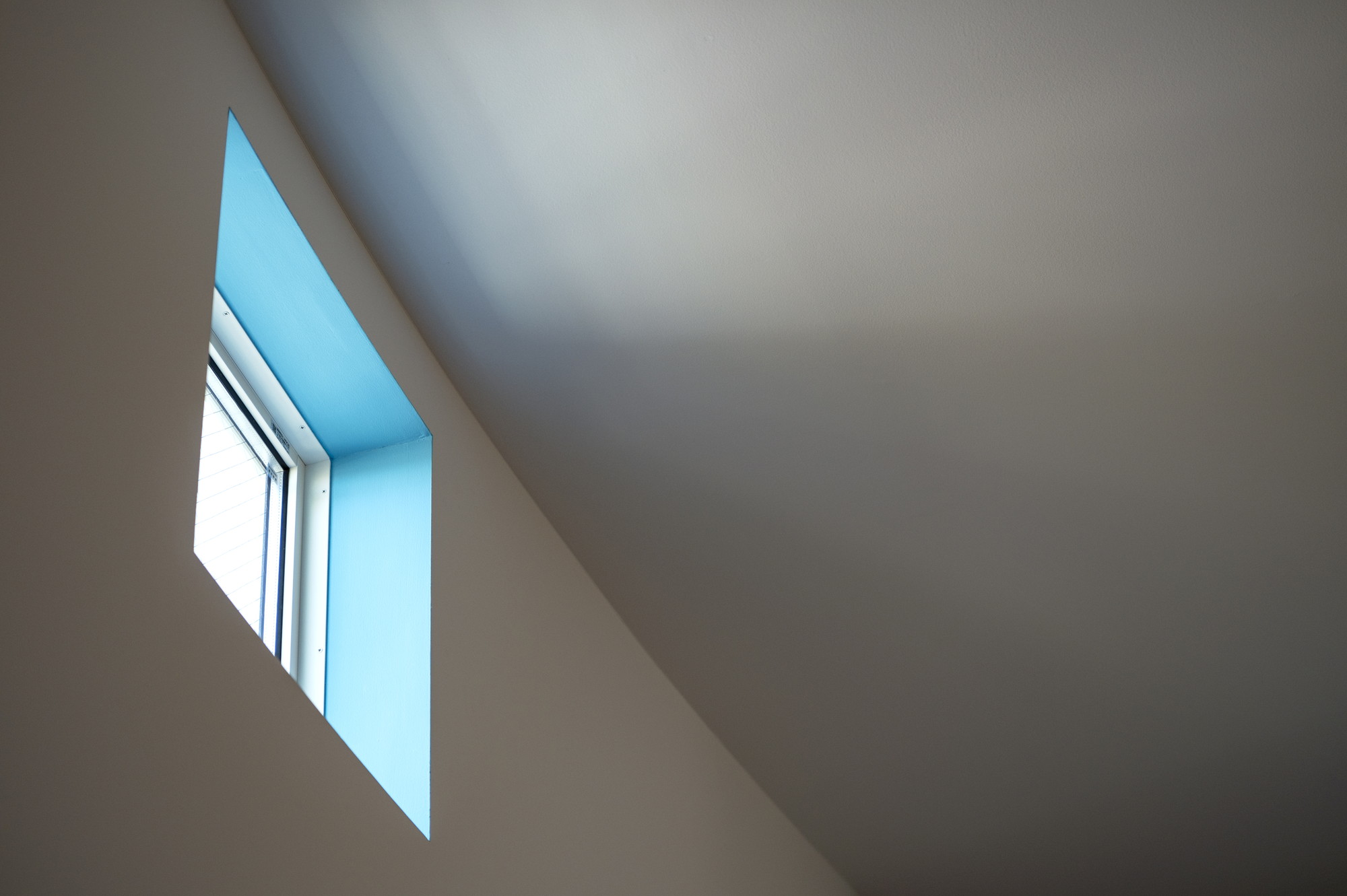
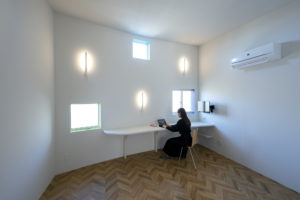
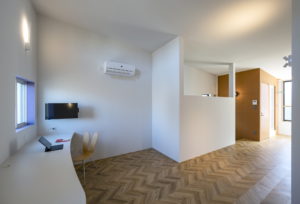
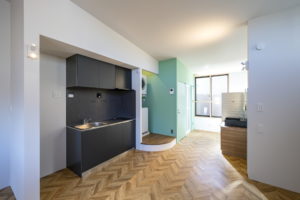
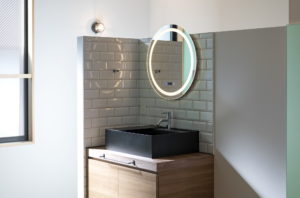
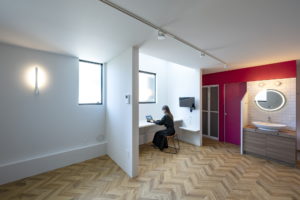

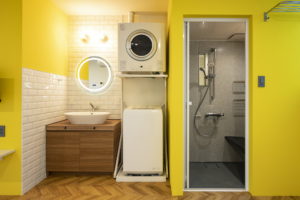
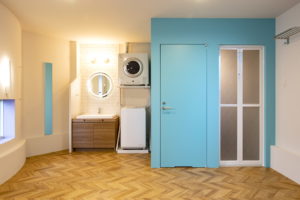
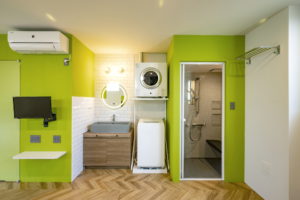
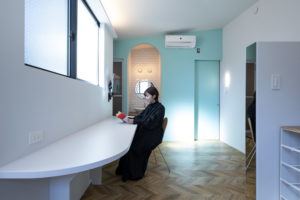
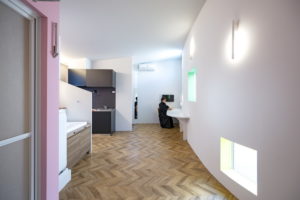
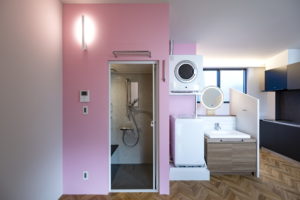
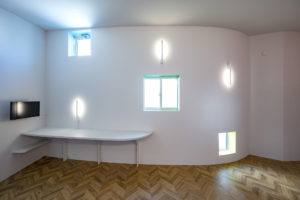
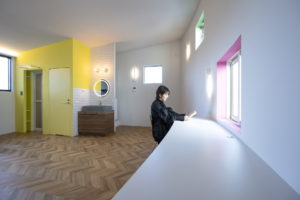
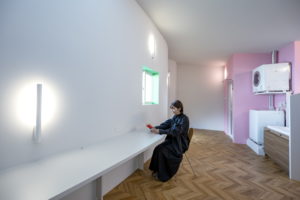
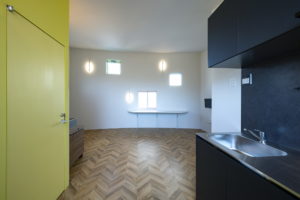
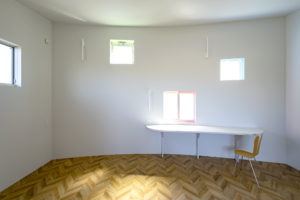
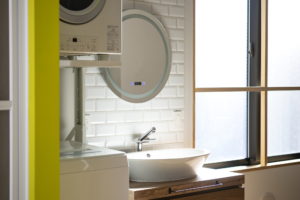
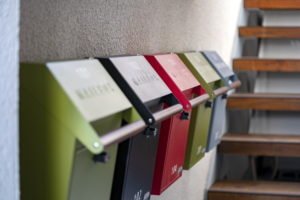
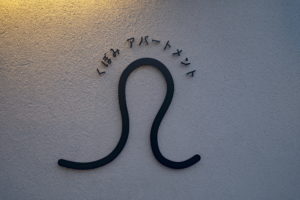
All Photo by Y.Okamura
くぼみアパートメント ~街のくぼみ~
設計依頼を受けたアパートの計画地は、最寄駅から徒歩数分程の市街地に位置し、東西南と住宅や集合住宅に囲われ、北側が道路に面した敷地であった。近くには大きな病院や看護学校があるため、そこで働くスタッフや都内の大学に通う学生のワンルームとしてニーズがあると考えていた。しかし、すでに近隣にアパートメーカーが建設した数多くのワンルームアパートが点在しており、その中には空室率が高いアパートも見受けられた。
施主からは融資金額内で中長期的に空室率を増やさないように依頼された。そのため、アパートメーカーと差別化した設計が必要であり、従来のアパートにはない魅力を価値づけするように計画する必要があった。
上記施主要素や敷地関連要素が上がるものの、昨今の社会情勢から、単身用の住まいの問題点を自問してみた。そこで「コロナ禍」の住まい方、「シェアする人々」の特性、「孤立しない集合住宅」の必要性が上がってきた。
・「コロナ禍」の住まいでは、生活習慣として手洗い・うがい、シャワー(入浴)、換気・通気などが速やかにできるとありがたい。
・次に「シェア」について2点の自分の考えが浮かんだ。
1点は「シェア」といえば聞こえが良く上手く繋がれる言葉に聞こえるが、実際は年齢や考え方などの「似たもの同士」「特定多数」は上手くいきがちだが、「全くの見知らぬ人」「様々な違う考え方を持った同士、不特定多数の場合は、心に距離感があり、上手くいくとは限らないことが多い。これは、自らも経験がある。
そのため、本計画は不特定の者たちが入居することが想定されるため、(シェアは必要なんだけれども)シェアしすぎることには、要注意だという意識が働いた。
2点目は過度な「空間のシェア」はコロナ禍感染症対策においてはデメリットであるため、室内は個別化して別の換気が良いところでのシェアを配慮する必要があると考えた。
・「孤立しない住まい方」の実現に向けて
孤立が犯罪を生むことという記事を目にすることが多くなり、だれか話ができる人や思いやれる人がいるということは、本来の人間性を取り戻せるよりどころになる。
隣にどのような住人が住んでいるか知らない人も多いる存在しているだろう、上階の人の音も知らない人の音は騒音だが、知っている人だと「あ、何々してるのかな?」とイライラの程度も異なる。
少しでも挨拶できたり、お互いのことの話ができれば、おすそ分けのようなことに繋がるかもしれないし、困りごとなど相談できるかもしれない。そういう環境があれば、心が繋がれ、孤立感が薄まり、気持ちが少しでも安定する。
単身者用の住まいはそういうケースであってほしいと願っている。
目指したこの集合住宅の住まい方は「単身者同士が同じ屋根の下でお互いを気遣いながら生活ができること。また、住人同士が仲良くコミュニケーションが取れて、孤立しないような住戸の関係づくり」とし、魅力を価値づけられるように検討した。
そこで、オーソドックスではあるのだが、中央に住民同士が語らえる場を囲う形で計画できないか?ひいては住民だけでなく街の人とも繋がり合えるフラットな空間を目指し、「単身の孤立から繋がり」へと変換できるよう、空虚な中庭にならないように模索をした。
計画自体がコロナ禍の2020年8月から始まったため、前述した単身者の暮らしのあり方や生活習慣、そして「シェアすること」について考えを巡らせ、計画を始めた。
近隣には医療関係者も多く、コロナも蔓延しているため、部屋は個室化を選択した。敷地の形・大きさ、木造での検討や法規的制約から2階建てで計画し、医療関係者や不規則職業時間者のニーズを考え、音が伝わりにくいプラン・構造(床壁天井)にした。住戸内は各室の面積確保を最大限にするため、バルコニーをなくし、ユニットバスをベンチ付きのユニットシャワーとして省スペースを図り、24h洗濯可能なガス乾燥機を各戸設置し、手洗いうがいができる洗面台などを充実させた設計とした。水回りの一部にカラーを配し、非単調さを住み手に印象付けられるようにし、愛着が持てるように考えた。
さらに、外部でコミュニケーションを図るため、住人同士が語らえ、かつ街の人も入ってきやすい中庭形状を検討した。中庭を構成するために建物を2棟に別け、人が近づきたくなり、かつスリップインしたくなるようなカーブの平面がある「道路からのくぼみ」を作り、道路と中庭のアスファルトを一体化して見えるようにすることで「くぼみ」に住人や街の人々が集まりやすいように考慮した。「くぼみ」を起点に住民や近隣の人々が集まり、共に語り合えるような、街の一角となるように考慮した。
今回設計したアパートはコロナ禍で医療関係者も多くいることを踏まえ、最終的には安易に空間共有を広げることは避けた。ただ、昨今の大きな社会問題である「孤立」を避けられるように、気遣える距離感をプランニングした。このアパートが画一的で隣人に無関心でない社会を目指せる一つになってゆけることを願っている。
Kubomi Apartments – A Pocket in the City
The site for this urban apartment project was located about several minutes on foot from the nearest station. It was surrounded by houses and residential complexes except to the north, which borders a street. Large hospitals and nursing schools in the area made us imagine that local staff and students commuting to Tokyo universities probably drive demand for studio apartments here, but many such apartments made by larger builders already existed around the neighborhood, and some had high vacancy rates.
That’s why the architecture had to stand out and offer tenants something special, within budget, to keep the vacancy rate steady over the medium to long term as requested by the client. In design, we would be encouraging tenants to be considerate neighbors, as single people living under the same roof – a friendly place, with communication preventing isolation. This inspired the idea of a central courtyard, which is not necessarily unusual but still provides a place for residents to linger for a chat. Kubomi means “pocket,” among other things, so it’s a fitting description for this gathering place. Besides fostering these ties, the courtyard also links the apartments to the neighborhood, forming a space that can replace the isolation of solitary tenants with a sense of being part of a community.
The project start date in August 2020 during the pandemic meant that we paid closer attention to certain topical issues: ideal lives/lifestyles for single people, how people share things with each other, and how to support this sharing. The decision to build studio apartments responded to the neighborhood’s high concentration of medical professionals and the fact that the pandemic was spreading. A two-story structure here would suit the lot shape and size, our preference for wooden construction, and the need to meet building codes. Quiet units are an advantage when tenants include medical professionals and workers with irregular hours, so this was a priority in planning and construction of the floors, walls, and ceilings, while forgoing balconies, electric clothes dryers, and modular bathrooms (in favor of modular showers with benches) ensured maximum space inside and room for other fixtures, such as hygienic washbasins. To add variety and endear tenants to the units, we also suggested accentuating some sink areas with a dash of color.
Setting the scene not only for tenant interaction but also community communication is the carefully designed shape of the inviting, accessible courtyard. Formed by dividing the building into two separate structures with curved walls, it creates an inlet from the street that tempts people to approach and slip in. Another touch that draws people in is the seamless merging of the road with the asphalt of the courtyard.
In consideration of the pandemic, ease of expanding shared spaces was not addressed in the design of the apartments, but we did seek to avoid people feeling isolated – another significant social issue for some time – by planning a sense of privacy that also allows tenants to be mindful of each other. We hope that in some way, the apartments help break down excessive uniformity in society and indifference to one’s neighbors.